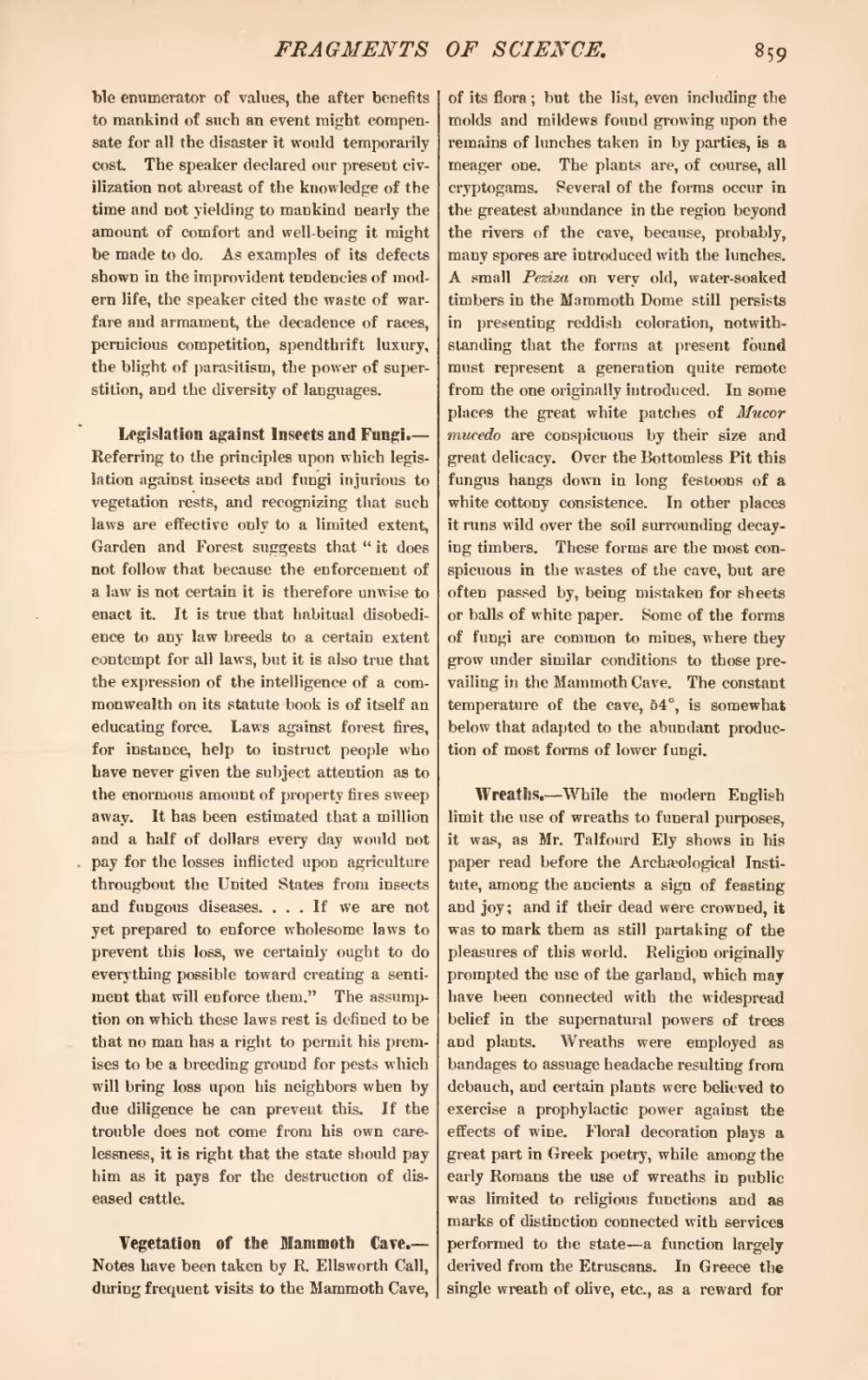ble enumerator of values, the after benefits to mankind of such an event might compensate for all the disaster it would temporarily cost. The speaker declared our present civilization not abreast of the knowledge of the time and not yielding to mankind nearly the amount of comfort and well-being it might be made to do. As examples of its defects shown in the improvident tendencies of modern life, the speaker cited the waste of warfare and armament, the decadence of races, pernicious competition, spendthrift luxury, the blight of parasitism, the power of superstition, and the diversity of languages.
Legislation against Insects and Fungi.—Referring to the principles upon which legislation against insects and fungi injurious to vegetation rests, and recognizing that such laws are effective only to a limited extent. Garden and Forest suggests that "it does not follow that because the enforcement of a law is not certain it is therefore unwise to enact it. It is true that habitual disobedience to any law breeds to a certain extent contempt for all laws, but it is also true that the expression of the intelligence of a commonwealth on its statute book is of itself an educating force. Laws against forest fires, for instance, help to instruct people who have never given the subject attention as to the enormous amount of property fires sweep away. It has been estimated that a million and a half of dollars every day would not pay for the losses inflicted upon agriculture throughout the United States from insects and fungous diseases. . . . If we are not yet prepared to enforce wholesome laws to prevent this loss, we certainly ought to do everything possible toward creating a sentiment that will enforce them." The assumption on which these laws rest is defined to be that no man has a right to permit his premises to be a breeding ground for pests which will bring loss upon his neighbors when by due diligence he can prevent this. If the trouble does not come from his own carelessness, it is right that the state should pay him as it pays for the destruction of diseased cattle.
Vegetation of the Mammoth Cave.—Notes have been taken by R. Ellsworth Call, during frequent visits to the Mammoth Cave, of its flora; but the list, even including the molds and mildews found growing upon the remains of lunches taken in by parties, is a meager one. The plants are, of course, all cryptogams. Several of the forms occur in the greatest abundance in the region beyond the rivers of the cave, because, probably, many spores are introduced with the lunches. A small Peziza on very old, water-soaked timbers in the Mammoth Dome still persists in presenting reddish coloration, notwithstanding that the forms at present found must represent a generation quite remote from the one originally introduced. In some places the great white patches of Mucor mucedo are conspicuous by their size and great delicacy. Over the Bottomless Pit this fungus hangs down in long festoons of a white cottony consistence. In other places it runs wild over the soil surrounding decaying timbers. These forms are the most conspicuous in the wastes of the cave, but are often passed by, being mistaken for sheets or balls of white paper. Some of the forms of fungi are common to mines, where they grow under similar conditions to those prevailing in the Mammoth Cave. The constant temperature of the cave, 54°, is somewhat below that adapted to the abundant production of most forms of lower fungi.
Wreaths.—While the modern English limit the use of wreaths to funeral purposes, it was, as Mr. Talfourd Ely shows in his paper read before the Archæological Institute, among the ancients a sign of feasting and joy; and if their dead were crowned, it was to mark them as still partaking of the pleasures of this world. Religion originally prompted the use of the garland, which may have been connected with the widespread belief in the supernatural powers of trees and plants. Wreaths were employed as bandages to assuage headache resulting from debauch, and certain plants were believed to exercise a prophylactic power against the effects of wine. Floral decoration plays a great part in Greek poetry, while among the early Romans the use of wreaths in public was limited to religious functions and as marks of distinction connected with services performed to the state—a function largely derived from the Etruscans. In Greece the single wreath of olive, etc., as a reward for
